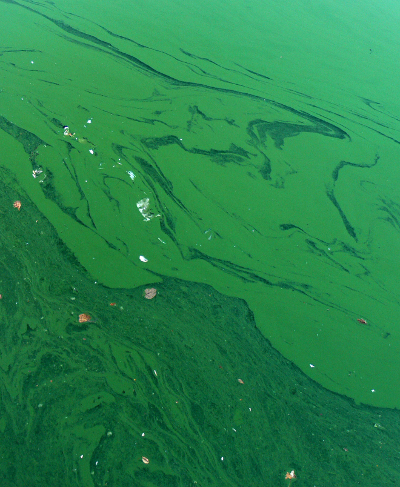Deadly toxin spotted on blooms
 A toxin known as the ‘Very Fast Death Factor’ has been found in the air above an algal bloom.
A toxin known as the ‘Very Fast Death Factor’ has been found in the air above an algal bloom.
Pond scum - otherwise known as algal bloom - is an unsightly formation which occurs in still water around the world.
These blooms often include the algal toxin anatoxin-a (ATX) which is also known as ‘Very Fast Death Factor’.
ATX can cause a range of symptoms including loss of coordination, muscular twitching and respiratory paralysis, and has been linked to the deaths of livestock, waterfowl and dogs that drink contaminated water.
ATX and algal blooms themselves are produced by single-celled organisms known as cyanobacteria, which cause a bloom when they grow in lake surface waters.
Blooms are exacerbated by fertiliser run-off entering lakes or ponds from nearby fields or improperly treated wastewater, and can stimulate growth and high water temperatures.
Cyanobacteria, which also are known as blue-green algae, are actually a type of bacteria that can photosynthesise.
Cyanobacterial blooms create lead to low oxygen conditions, degrading water quality. When the algae in these large blooms die, they sink to the lake bottom and decompose, using up all the oxygen in the water, killing fish and other animals. The blooms also can release toxins into the water.
In a recent study from the US, scientists say that for the first time, they have detected the ATX toxin in the air as well as the water.
“ATX is one of the more dangerous cyanotoxins produced by harmful algal blooms, which are becoming more predominant in lakes and ponds worldwide due to global warming and climate change,” says lead author Dr James Sutherland, at the Nantucket Land Council.
The research team was able to collect samples of airborne particles by sucking air through a glass fibre filter from around the edge of a pond on Nantucket Island in Massachusetts, at a time when it was regularly covered with algal blooms.
Not only were they able to detect ATX in the pond water, at concentrations of up to 21ng/mg, but on one occasion they also detected it in the air around the pond, at an average concentration of 0.87ng/filter, which corresponds to a potential airborne exposure of 0.16ng/m3.
This detection occurred on a foggy day in September, after a windy night, when the ATX was likely blown from the surface of the water by the strong wind and then protected by the fog, allowing it to be detected.
The researchers are unsure exactly how ATX is released into the air from the pond, whether within small water droplets, attached to aerosol particles or even inside cyanobacteria blown into the air.
It is also unclear what effects exposure to these trace concentrations of ATX might have on humans and wildlife, but the experts say that the fact there is exposure is clearly a cause for concern and requires further research.








 Print
Print